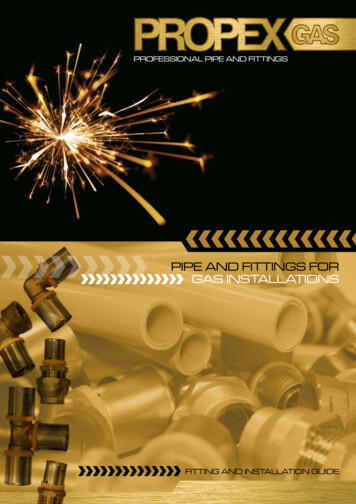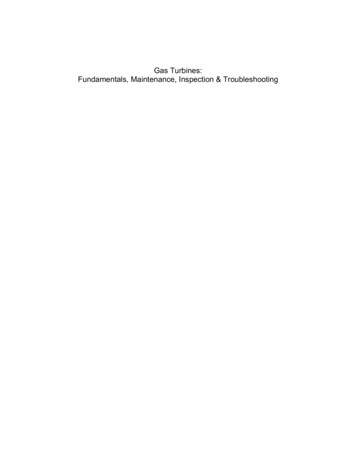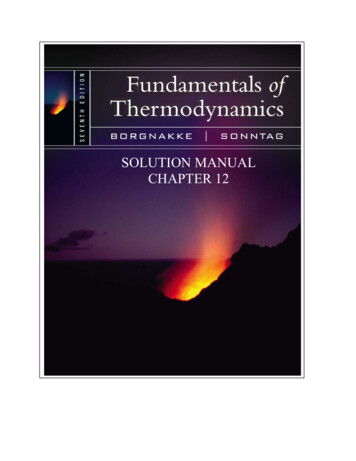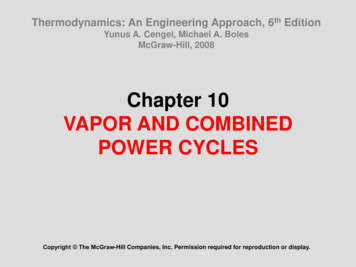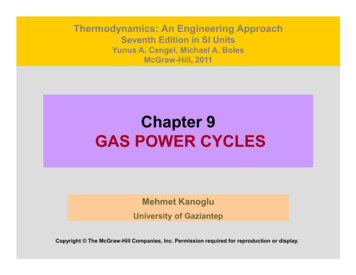
Transcription
Thermodynamics: An Engineering ApproachSeventh Edition in SI UnitsYunus A. Cengel, Michael A. BolesMcGraw-Hill, 2011Chapter 9GAS POWER CYCLESMehmet KanogluUniversity of GaziantepCopyright The McGraw-Hill Companies, Inc. Permission required for reproduction or display.
Objectives Evaluate the performance of gas power cycles for which theworking fluid remains a gas throughout the entire cycle. Develop simplifying assumptions applicable to gas powercycles. Review the operation of reciprocating engines. Analyze both closed and open gas power cycles. Solve problems based on the Otto, Diesel, Stirling, andEricsson cycles. Solve problems based on the Brayton cycle; the Brayton cyclewith regeneration; and the Brayton cycle with intercooling,reheating, and regeneration. Analyze jet-propulsion cycles. Identify simplifying assumptions for second-law analysis ofgas power cycles. Perform second-law analysis of gas power cycles.2
BASIC CONSIDERATIONS IN THE ANALYSISOF POWER CYCLESThermal efficiencyMost power-producing devices operate on cycles.Ideal cycle: A cycle that resembles the actual cycleclosely but is made up totally of internally reversibleprocesses.of heat engines:Reversible cycles such as Carnot cycle have thehighest thermal efficiency of all heat enginesoperating between the same temperature levels.Unlike ideal cycles, they are totally reversible, andunsuitable as a realistic model.Modeling is apowerfulengineering toolthat provides greatinsight andThe analysis of many complexsimplicity at theprocesses can be reduced toexpense of somea manageable level byloss in accuracy.utilizing some idealizations.3
The ideal cycles are internally reversible, but, unlike the Carnot cycle, they are notnecessarily externally reversible. Therefore, the thermal efficiency of an idealcycle, in general, is less than that of a totally reversible cycle operating betweenthe same temperature limits. However, it is still considerably higher than thethermal efficiency of an actual cycle because of the idealizations utilized.4
On a T-s diagram, the ratio of thearea enclosed by the cyclic curve tothe area under the heat-additionprocess curve represents the thermalefficiency of the cycle. Anymodification that increases the ratioof these two areas will also increasethe thermal efficiency of the cycle.Care should be exercisedin the interpretation of theresults from ideal cycles.The idealizations and simplifications in theanalysis of power cycles:1. The cycle does not involve any friction.Therefore, the working fluid does notexperience any pressure drop as it flows inpipes or devices such as heat exchangers.2. All expansion and compression processestake place in a quasi-equilibrium manner.3. The pipes connecting the variouscomponents of a system are wellinsulated, and heat transfer through themis negligible.On both P-v and T-s diagrams, the area enclosedby the process curve represents the net work of thecycle.5
THE CARNOT CYCLE AND ITSVALUE IN ENGINEERINGThe Carnot cycle is composed of four totally reversibleprocesses: isothermal heat addition, isentropicexpansion, isothermal heat rejection, and isentropiccompression.For both ideal and actual cycles: Thermal efficiencyincreases with an increase in the average temperatureat which heat is supplied to the system or with adecrease in the average temperature at which heat isrejected from the system.A steady-flow Carnot engine.P-v and T-s diagrams ofa Carnot cycle.6
AIR-STANDARD ASSUMPTIONSAir-standard assumptions:1. The working fluid is air, whichcontinuously circulates in a closed loopand always behaves as an ideal gas.2. All the processes that make up thecycle are internally reversible.3. The combustion process is replaced bya heat-addition process from anexternal source.4. The exhaust process is replaced by aheat-rejection process that restores theworking fluid to its initial state.The combustion process is replaced bya heat-addition process in ideal cycles.Cold-air-standard assumptions: When the working fluid is consideredto be air with constant specific heats at room temperature (25 C).Air-standard cycle: A cycle for which the air-standard assumptions areapplicable.7
AN OVERVIEW OF RECIPROCATING ENGINESCompression ratio Mean effectivepressureSpark-ignition (SI) enginesCompression-ignition (CI) enginesNomenclature for reciprocating engines.8
OTTO CYCLE: THE IDEAL CYCLE FORSPARK-IGNITION ENGINESActual and ideal cycles in spark-ignition engines and their P-v diagrams.9
Four-stroke cycle1 cycle 4 stroke 2 revolutionTwo-stroke cycle1 cycle 2 stroke 1 revolutionT-s diagramof the idealOtto cycle.The two-stroke engines aregenerally less efficient thantheir four-stroke counterpartsbut they are relatively simpleand inexpensive, and theyhave high power-to-weightand power-to-volume ratios.Schematic of a two-strokereciprocating engine.10
11
In SI engines,thecompressionratio is limitedbyautoignitionor engineknock.Thermal efficiency of the idealOtto cycle as a function ofcompression ratio (k 1.4).The thermal efficiency of theOtto cycle increases with thespecific heat ratio k of theworking fluid.12
DIESEL CYCLE: THE IDEAL CYCLEFOR COMPRESSION-IGNITION ENGINESIn diesel engines, only air is compressed during thecompression stroke, eliminating the possibility ofautoignition (engine knock). Therefore, diesel enginescan be designed to operate at much higher compressionratios than SI engines, typically between 12 and 24.1-2 isentropiccompression2-3 constantvolume heataddition3-4 isentropicexpansion4-1 constantvolume heatrejection.In diesel engines, the spark plug is replacedby a fuel injector, and only air is compressedduring the compression process.13
Cutoffratiofor the same compression ratioThermalefficiency of theideal Diesel cycleas a function ofcompression andcutoff ratios(k 1.4).14
Dual cycle: A more realisticQUESTIONS ?ideal cycle model for modern,high-speed compression ignitionengine.Diesel engines operate athigher air-fuel ratios thangasoline engines. Why?Despite higher power toweight ratios, two-strokeengines are not used inautomobiles. Why?The stationary dieselengines are among themost efficient powerproducing devices (about50%). Why?P-v diagram of an ideal dual cycle.What is a turbocharger?Why are they mostly usedin diesel enginescompared to gasolineengines.15
STIRLING AND ERICSSON CYCLESStirling cycle1-2 T constant expansion (heat addition from the external source)2-3 v constant regeneration (internal heat transfer from the working fluid to the regenerator)3-4 T constant compression (heat rejection to the external sink)4-1 v constant regeneration (internal heat transfer from the regenerator back to the workingfluid)A regenerator is a device thatborrows energy from the workingfluid during one part of the cycleand pays it back (withoutinterest) during another part.T-s and P- vdiagrams of Carnot, Stirling, and Ericsson cycles. 16
The Stirling and Ericsson cyclesgive a message: Regenerationcan increase efficiency.Both the Stirling and Ericsson cycles aretotally reversible, as is the Carnot cycle,and thus:The Ericsson cycle is very much like theStirling cycle, except that the two constantvolume processes are replaced by twoconstant-pressure processes.The execution of the Stirling cycle.A steady-flow Ericsson engine.17
BRAYTON CYCLE: THE IDEAL CYCLEFOR GAS-TURBINE ENGINESThe combustion process is replaced by a constant-pressure heat-additionprocess from an external source, and the exhaust process is replaced by aconstant-pressure heat-rejection process to the ambient air.1-2 Isentropic compression (in a compressor)2-3 Constant-pressure heat addition3-4 Isentropic expansion (in a turbine)4-1 Constant-pressure heat rejectionAn open-cycle gas-turbine engine.A closed-cycle gas-turbine engine.18
PressureratioT-s and P-v diagrams forthe ideal Brayton cycle.Thermalefficiency of theideal Braytoncycle as afunction of thepressure ratio.19
The two major application areas of gasturbine engines are aircraft propulsionand electric power generation.The highest temperature in the cycle islimited by the maximum temperature thatthe turbine blades can withstand. Thisalso limits the pressure ratios that can beused in the cycle.The air in gas turbines supplies thenecessary oxidant for the combustion ofthe fuel, and it serves as a coolant tokeep the temperature of variouscomponents within safe limits. An air–fuelratio of 50 or above is not uncommon.The fraction of the turbine workused to drive the compressor iscalled the back work ratio.20
Development of Gas Turbines1. Increasing the turbine inlet (or firing) temperatures2. Increasing the efficiencies of turbomachinery components (turbines,compressors):3. Adding modifications to the basic cycle (intercooling, regeneration orrecuperation, and reheating).Deviation of Actual GasTurbine Cycles from IdealizedOnesReasons: Irreversibilities in turbine andcompressors, pressure drops, heat lossesIsentropic efficiencies of the compressorand turbineThe deviation of an actual gasturbine cycle from the idealBrayton cycle as a result ofirreversibilities.21
THE BRAYTON CYCLE WITHREGENERATIONIn gas-turbine engines, the temperature of the exhaustgas leaving the turbine is often considerably higher thanthe temperature of the air leaving the compressor.Therefore, the high-pressure air leaving the compressorcan be heated by the hot exhaust gases in a counter-flowheat exchanger (a regenerator or a recuperator).The thermal efficiency of the Brayton cycle increases as aresult of regeneration since less fuel is used for the samework output.T-s diagram of aBrayton cycle withregeneration.A gas-turbineengine withregenerator.22
Effectivenessof regeneratorEffectiveness under coldair standard assumptionsUnder cold-airstandard assumptionsT-s diagram of a Braytoncycle with regeneration.The thermal efficiencydepends on the ratio of theminimum to maximumtemperatures as well as thepressure ratio.Regeneration is mosteffective at lower pressureratios and low minimum-tomaximum temperature ratios.Can regenerationbe used at highpressure ratios?Thermalefficiency of theideal Braytoncycle with andwithoutregeneration.23
THE BRAYTON CYCLE WITH INTERCOOLING,REHEATING, AND REGENERATIONFor minimizing work input to compressorand maximizing work output from turbine:A gas-turbine enginewith two-stagecompression withintercooling, twostage expansionwith reheating, andregeneration and itsT-s diagram.24
Multistage compression with intercooling: The work required to compress a gasbetween two specified pressures can be decreased by carrying out the compressionprocess in stages and cooling the gas in between. This keeps the specific volume as lowas possible.Multistage expansion with reheating keeps the specific volume of the working fluid ashigh as possible during an expansion process, thus maximizing work output.Intercooling and reheating always decreases the thermal efficiency unless they areaccompanied by regeneration. Why?Comparisonof work inputsto a singlestagecompressor(1AC) and atwo-stagecompressorwithintercooling(1ABD).As the number of compression and expansionstages increases, the gas-turbine cycle withintercooling, reheating, and regenerationapproaches the Ericsson cycle.25
IDEAL JET-PROPULSION CYCLESGas-turbine engines are widely used to power aircraft because they are light andcompact and have a high power-to-weight ratio.Aircraft gas turbines operate on an open cycle called a jet-propulsion cycle.The ideal jet-propulsion cycle differs from the simple ideal Brayton cycle in that thegases are not expanded to the ambient pressure in the turbine. Instead, they areexpanded to a pressure such that the power produced by the turbine is just sufficient todrive the compressor and the auxiliary equipment.The net work output of a jet-propulsion cycle is zero. The gases that exit the turbine at arelatively high pressure are subsequently accelerated in a nozzle to provide the thrust topropel the aircraft.Aircraft are propelled by accelerating a fluid in the opposite direction to motion. This isaccomplished by either slightly accelerating a large mass of fluid (propeller-drivenengine) or greatly accelerating a small mass of fluid (jet or turbojet engine) or both(turboprop engine).In jet engines, the hightemperature and highpressure gases leaving theturbine are accelerated in anozzle to provide thrust.26
Thrust (propulsive force)Propulsive efficiencyPropulsive powerPropulsive power isthe thrust acting on theaircraft through adistance per unit time.Basic components of a turbojet engine and the T-s diagram for the ideal turbojet cycle.27
28
Modifications to Turbojet EnginesThe first airplanes built were all propeller-driven, with propellers powered byengines essentially identical to automobile engines.Both propeller-driven engines and jet-propulsion-driven engines have their ownstrengths and limitations, and several attempts have been made to combine thedesirable characteristics of both in one engine.Two such modifications are the propjet engine and the turbofan engine.The most widely used engine in aircraft propulsion is the turbofan (or fanjet)engine wherein a large fan driven by the turbine forces a considerableamount of air through a duct (cowl) surrounding the engine.Aturbofanengine.29
30
Various engine types:Turbofan, Propjet, Ramjet, Sacramjet, RocketA turbopropengine.A ramjetengine.31
SECOND-LAW ANALYSIS OF GAS POWER CYCLESExergydestruction for aclosed systemFor a steadyflow systemSteady-flow, one-inlet, one-exitExergy destruction of a cycleFor a cycle with heat transferonly with a source and a sinkClosed system exergyStream exergyA second-law analysis of these cycles reveals where the largestirreversibilities occur and where to start improvements.32
Summary Basic considerations in the analysis of power cyclesThe Carnot cycle and its value in engineeringAir-standard sssumptionsAn overview of reciprocating enginesOtto cycle: The ideal cycle for spark-ignition enginesDiesel cycle: The ideal cycle for compression-ignitionenginesStirling and Ericsson cyclesBrayton cycle: The ideal cycle for gas-turbine enginesThe Brayton cycle with regenerationThe Brayton cycle with intercooling, reheating, andregenerationIdeal jet-propulsion cyclesSecond-law analysis of gas power cycles33
Evaluate the performance of gas power cycles for which the working fluid remains a gas throughout the entire cycle. Develop simplifying assumptions applicable to gas power cycles. Review the operation of reciprocating engines. Analyze both closed and open gas power cycles. Solve problems based on the Otto, Diesel, Stirling .





